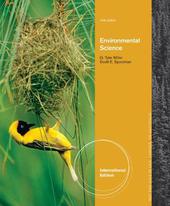
|
Environmental Science, International Edition
Paperback
Main Details
| Title |
Environmental Science, International Edition
|
| Authors and Contributors |
By (author) Scott Spoolman
|
|
By (author) G. Tyler Miller
|
| Physical Properties |
| Format:Paperback | | Pages:576 | | Dimensions(mm): Height 277,Width 230 |
|
| Category/Genre | Sustainability
Environmental science, engineering and technology |
|---|
| ISBN/Barcode |
9781133104391
|
| Classifications | Dewey:333.72 |
|---|
| Audience | | Tertiary Education (US: College) | |
|---|
| Edition |
14th edition
|
|
Publishing Details |
| Publisher |
Cengage Learning, Inc
|
| Imprint |
Brooks/Cole
|
| Publication Date |
9 January 2012 |
| Publication Country |
United States
|
Description
ENVIRONMENTAL SCIENCE, 14E, International Edition will inspire and equip you to make a difference for the world. Featuring sustainability as their central theme, authors Tyler Miller and Scott Spoolman emphasize natural capital, natural capital degradation, solutions, trade-offs, and the importance of individuals. As a result, you will learn how nature works, how you interact with it, and how people have sustained-and can continue to sustain-our relationship with the earth by applying nature's lessons to economies and individual lifestyles. Engaging features like "Core Case Studies," and "Connections" boxes demonstrate the relevance of issues and encourage critical thinking. This edition has been updated with new learning tools, the latest content, and an enhanced art program. Two new active learning features found at the end of the book are linked with each chapter. "Doing Environmental Science" offers project ideas based on chapter content that build critical thinking skills and integrate scientific method principles. "Global Environmental Watch" offers online learning activities through the Global Environment Watch website, helping students connect the book's concepts to current real-world issues.
Author Biography
G. Tyler Miller has written 62 textbooks for introductory courses in environmental science, basic ecology, energy, and environmental chemistry. Since 1975, Miller's books have been the most widely used textbooks for environmental science in the United States and throughout the world. They have been used by almost three million students and have been translated into eight languages. Miller has a professional background in chemistry, physics, and ecology. He has a PhD from the University of Virginia and has received two honorary doctoral degrees for his contributions to environmental education. He taught college for 20 years, developed one of the nation's first environmental studies programs, and developed an innovative interdisciplinary undergraduate science program before deciding to write environmental science textbooks full time in 1975. Currently, he is the president of Earth Education and Research, which is devoted to improving environmental education. Scott Spoolman is a writer and textbook editor with more than 30 years of experience in educational publishing. He has worked with Tyler Miller since 2003 as a contributing author on editions of LIVING IN THE ENVIRONMENT, ENVIRONMENTAL SCIENCE, and SUSTAINING THE EARTH. With Norman Myers, he also coauthored ENVIRONMENTAL ISSUES AND SOLUTIONS: A MODULAR APPROACH. Spoolman holds a master's degree in science journalism from the University of Minnesota. He has authored numerous articles in the fields of science, environmental engineering, politics, and business. He worked as an acquisitions editor on a series of college forestry textbooks. He has also worked as a consulting editor in the development of over 70 college and high school textbooks in fields of the natural and social sciences. In his free time, he enjoys exploring the forests and waters of his native Wisconsin along with his family- his wife, environmental educator Gail Martinelli, and his children, Will and Katie.
ReviewsHUMANS AND SUSTAINABILITY: AN OVERVIEW. 1. Environmental Problems, Their Causes, and Sustainability. ECOLOGY AND SUSTAINABILITY. 2. Science, Matter, and Energy. 3. Ecosystems: What Are They and How Do They Work? 4. Biodiversity and Evolution. 5. Biodiversity, Species Interactions, and Population Control. 6. The Human Population and Urbanization. 7. Climate and Biodiversity. SUSTAINING BIODIVERSITY. 8. Sustaining Biodiversity: The Species Approach. 9. Sustaining Biodiversity: The Ecosystem Approach. SUSTAINING RESOURCES AND ENVIRONMENTAL QUALITY. 10. Food, Soil, and Pest Management. 11. Water Resources and Water Pollution. 12. Geology and Nonrenewable Minerals. 13. Energy. 14. Environmental Hazards and Human Health. 15. Air Pollution, Climate Change, and Ozone Depletion. 16. Solid and Hazardous Waste. SUSTAINING HUMAN SOCIETIES. 17. Environmental Economics, Politics, and Worldviews. SUPPLEMENTS. Supplement 1: Measurement Units Supplement 2: Reading Graphs and Maps Supplement 3: An Overview of U.S. Environmental History Supplement 4: Some Basic Chemistry Supplement 5: Weather Basics: El Nino, Tornadoes, and Tropical Cyclones Supplement 6: Maps Supplement 7: Environmental Data and Data Analysis Glossary. Index.
|